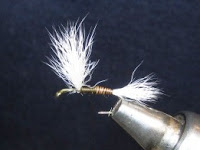This Bead Head Nymph Pattern is a true trout slayer. The Red Prince is my favorite Nymph to use when I float the Colorado River. This fly is an awesome attractor pattern and it will draw bites from fish when others won't. I tied this Red Prince in size #12, but I have used it bigger and smaller with great success.
Watch how to tie this fly:
~ Click on any image to enlarge ~
Materials List:
The Red Prince is as true trout slayer. This pattern definitely takes a beating. I suggest using a Tiemco 3761 size #12 or #14
This nymph pattern is tied with a copper colored fly tying bead.
Of course strong thread is important for nymphs this big.
The tail of this fly is tied with brown goose biots.
The wing of this prince nymph pattern is tied with white goose biots.
The Body of this fly is tied with red half round vinyl rib.
The Collar of this fly is tied with a few strands of peacock hurl.
Finally, the hackle of this Red Prince Nymph is tied with brown saddle hackle.
~ Click on any image to enlarge ~
Step By Step: How to tie a Red Prince Nymph
Start a nymph hook with a bead and thread.
Add two brown goose biots, splayed out, for the tail.
Tie in red half round vinyl for the rib of the fly. Be sure to tie the ribbing in with the round side to the hook so that when you wrap it forward the round side is out.
Next, add a couple strands of peacock hurl for the the collar of the fly.
 At this point, add a few turns of brown saddle hackle. After it is tied
off and clipped, created a "bed" for the wings by parting and mashing
the hackle flat on top.
At this point, add a few turns of brown saddle hackle. After it is tied
off and clipped, created a "bed" for the wings by parting and mashing
the hackle flat on top.
Finally add to white goose biots for the the wing. Complete this fly with a few tight whip finishes.
Red Prince Nymph
The Red Prince Nymph is one of my all time favorite nymphs to use, I always seem to be running low on them... until I tie my next dozen. I would invite you to fish with me on the Colorado River and see what I have learned about this fly. Float trips are a short drive from Aspen, CO and the fishing is out of this world, you will be impressed! Go to http://www.aspenflyfishing.com and book a couple days of incredible fishing.











































